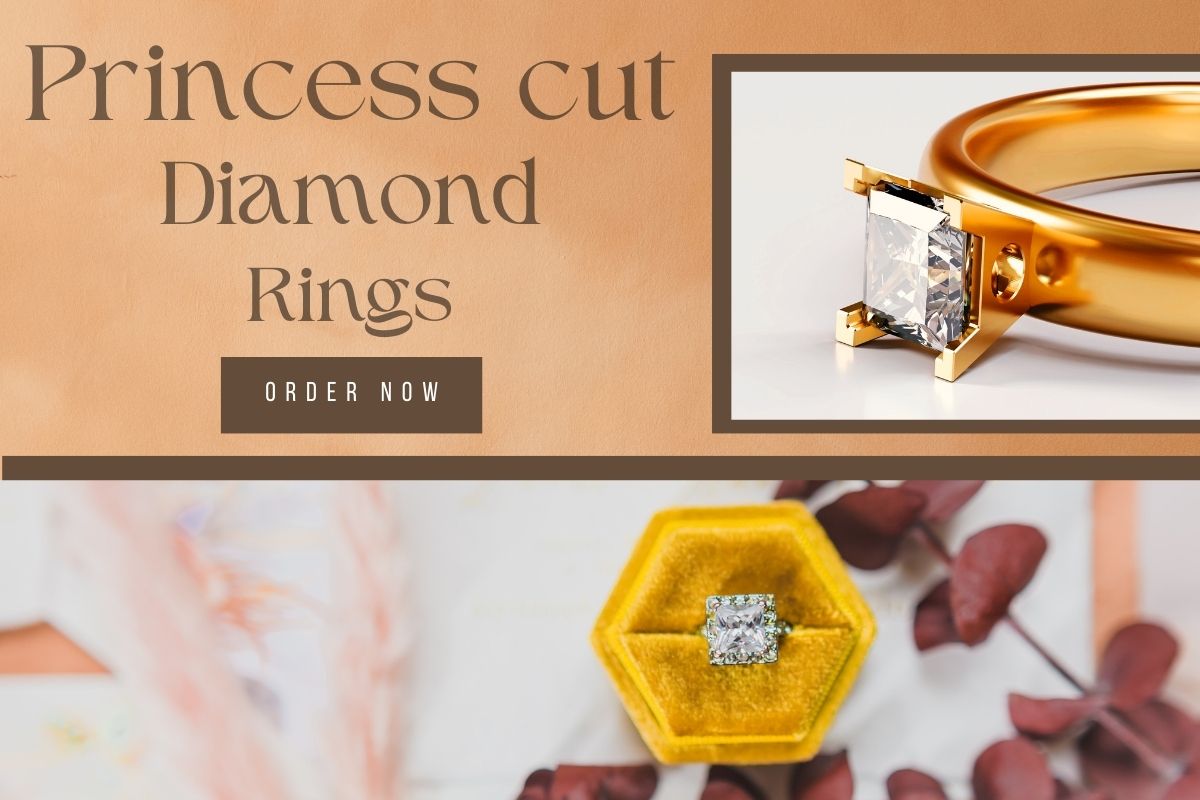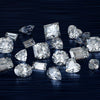
Princess Cut Diamond Size Chart: Your Guide to the Perfect Stone
When selecting a diamond, knowing the specifics of the cut is crucial. I understand that princess cut diamonds have gained popularity due to their modern, clean lines and brilliant sparkle. A princess cut diamond size chart is an essential tool I use to determine the dimensions of these diamonds based on their carat weight. It provides a clear visual representation, making it easier to comprehend how different carat weights translate into actual millimeter sizes.
I often turn to size charts as they help gauge the physical size of the diamond before purchase, which is especially important when shopping online. I use these charts to set realistic expectations on how the diamond will appear on a ring setting.
Table Of Contents
- Understanding Princess Cut Diamonds
- The Diamond Size Chart Explained
- Factors Affecting Diamond Size Perception
- Price Considerations and Value
- Buying Princess Cut Diamonds
- Diamond Care and Maintenance
- Sustainable and Ethical Considerations
- Final Thoughts on Princess Cut Diamonds
- Frequently Asked Questions
The charts account for the fact that princess cut diamonds can be slightly more variable in dimensions than round diamonds of the same carat weight due to the way they are cut. This means that two one-carat princess cut diamonds could present different dimensions, yet both will still align with the general size chart ranges for their weight category.
Understanding the relationship between carat weight and size is important not only for aesthetic considerations but also for value. I use the chart to navigate the balance between the size of a princess cut diamond and its other attributes, such as color, clarity, and cut quality. Since princess cut diamonds can vary in how square or rectangular they are, the size chart also helps confirm that the chosen diamond fits personal style preferences and harmonizes with the ring design intended.
Understanding Princess Cut Diamonds
In this section, I will shed light on princess cut diamonds, from their geometric allure to their striking design impact. We'll explore key facets of this popular diamond shape, giving you an insightful perspective on its aesthetic and technical attributes.
History and Origin
Princess cut diamonds emerged in the 1960s and 1970s, innovated by Betazel Ambar and Israel Itzkowitz. This newer cut was designed to create a more brilliant diamond that retains more crystal weight from the rough stone compared to traditional round cuts.
Defining Characteristics
Princess cut diamonds are known for their sharp angles and contemporary look. They are typically square but can also be slightly rectangular, with distinctive corners and numerous facets—usually 58 to 76—that contribute to their sparkle and brilliance. This cut is technically known as a "square modified brilliant," reflecting its stylistic origins from the round brilliant cut.
Cut Quality and Grading
The Gemological Institute of America (GIA) doesn't assign a cut grade to princess cuts, unlike the American Gem Society (AGS), which does. Instead, GIA provides grades for polish and symmetry. Cut quality impacts the diamond's sparkle and brilliance, with optimal proportions being crucial.
Size Interpretation and Measurement
When referring to princess cut diamond size charts, measurements are listed in millimeters (mm to carat or carat to mm). The size chart assists in visualizing the actual side length of a diamond as well as the conversion from carat weight to size and vice versa. For instance, a 1.00 carat princess cut might measure approximately 5.5 mm on each side.
Compared to round brilliant cuts, the princess cut often offers a more modern feel, while typically being less expensive due to its design maximizing the crystal weight. Other fancy shapes like pear, heart, or marquise often elongate the finger but might lack the princess cut's unique angular brilliance and sparkle.
Impact on Style and Design
Princess cut diamonds are versatile and can be the central jewel in various engagement ring styles, from solitaire and three-stone settings to vintage styles. Their clean lines and modern aesthetic adapt well to multiple settings, although protective prongs are often used to safeguard the corners.
| Carat Weight | Length (mm) | Width (mm) |
|---|---|---|
| 0.25 | 3.5 | 3.5 |
| 0.50 | 4.5 | 4.5 |
| 0.75 | 5.0 | 5.0 |
| 1.00 | 5.5 | 5.5 |
| 1.50 | 6.5 | 6.5 |
| 2.00 | 7.0 | 7.0 |
The Diamond Size Chart Explained
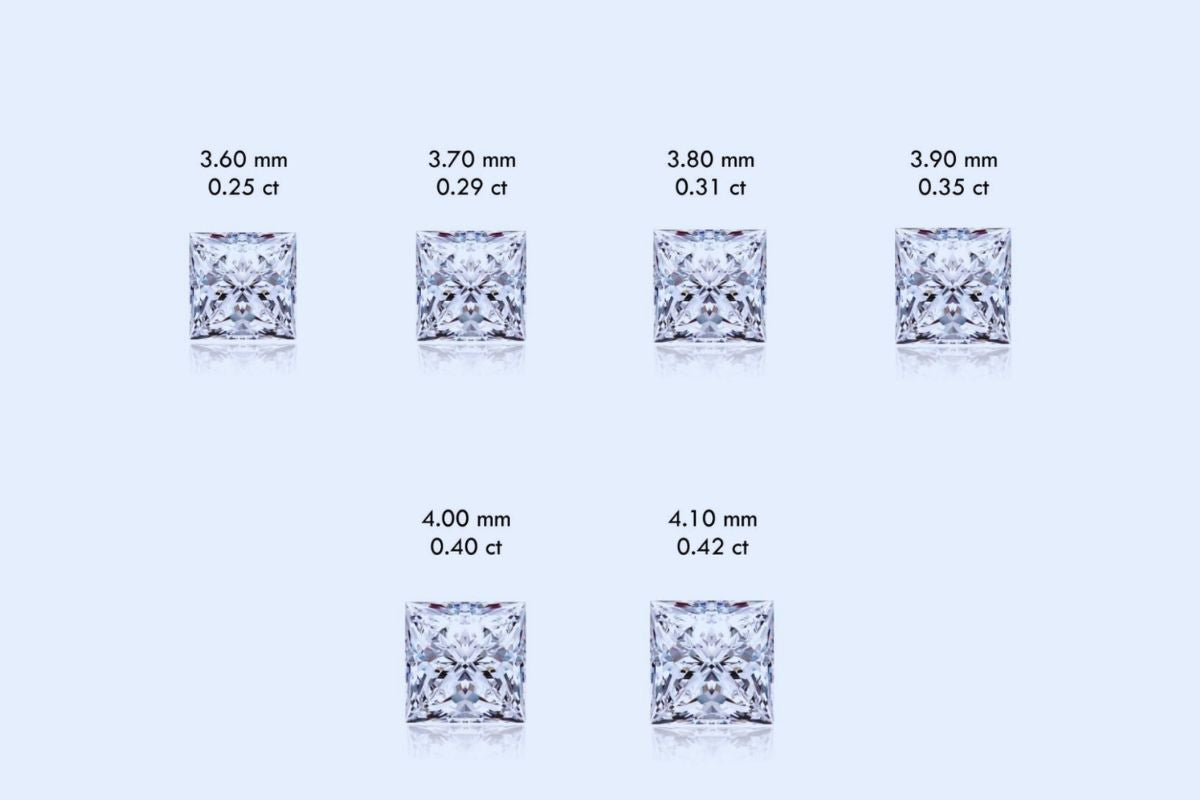
When searching for the perfect princess cut diamond for an engagement ring, it's crucial to understand the relationship between size, carat weight, and proportions. A diamond size chart is a valuable tool that converts millimeter measurements to carat weight, helping you to choose a diamond that fits your preferences and budget.
Navigating the Size Chart
I find that using a princess cut diamond size chart simplifies the selection process. This chart outlines the average measurements for diamonds, correlating the length and width in millimeters (mm) to the corresponding carat weight. It’s important to note that a diamond's dimensions are the key to understanding its size on the chart.
For example:
- A princess cut diamond measuring 3.25 mm typically equates to 0.25 carats.
- A 5 mm princess cut diamond often equals 0.75 carats.
Size Versus Carat Weight
Many people make the mistake of equating size directly with carat weight. However, carat weight actually refers to the mass of the diamond. A higher carat weight doesn't always mean a larger appearance. The cut quality and proportions must also be considered, as they play a significant role in how large the diamond appears. For princess cut diamonds, the ideal proportions ensure that the diamond's brilliance is maximized without making it appear smaller.
Visual Comparisons and Proportions
In my experience, a diamond's impact is not just in its weight but also its visual appeal. This is where the L/W ratio comes into play for princess cut diamonds. The right length-to-width ratio ensures a visually appealing symmetry that is integral to the princess cut's appeal. It's different from a round brilliant cut diamond, which usually doesn't have a length and width measurement due to its circular shape.
Factors Affecting Diamond Size Perception
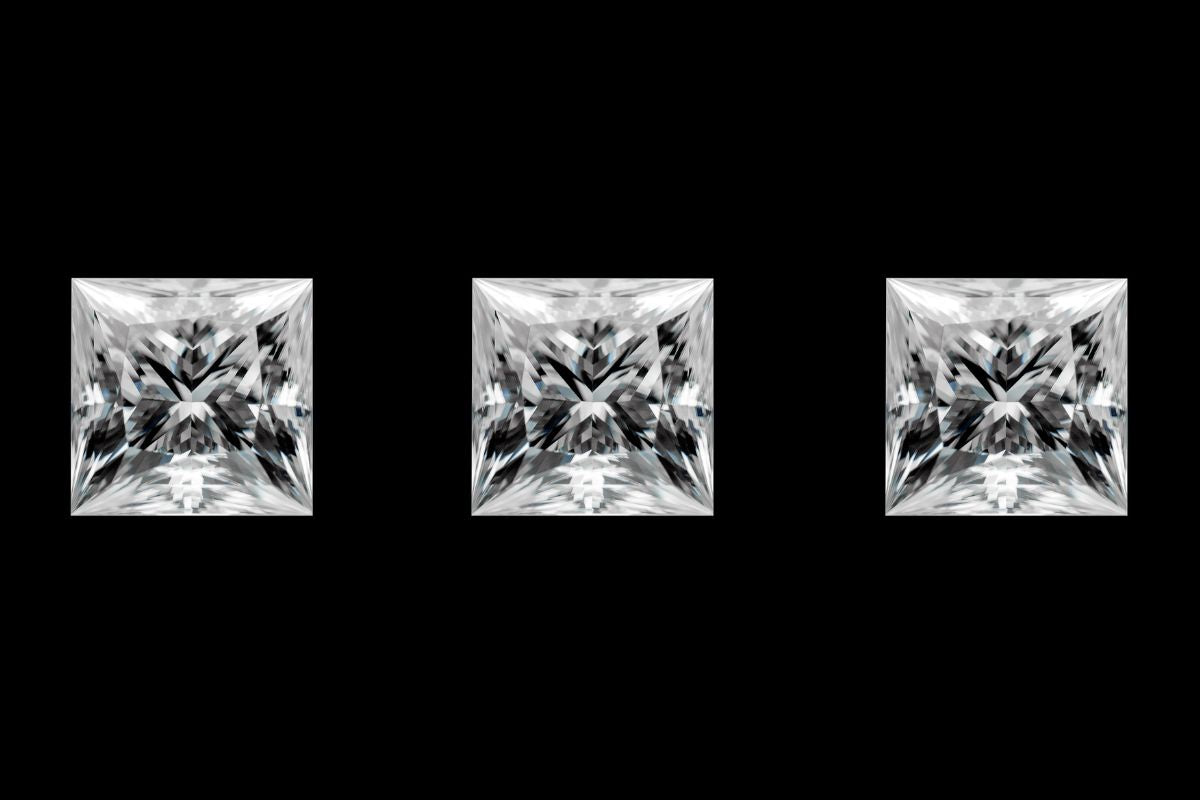
| Factor | Description |
|---|---|
| Carat Weight | Heavier diamonds are generally perceived as larger, although other factors such as cut can influence this perception. |
| Cut | A well-cut diamond can appear larger due to its ability to reflect light optimally, while a poorly cut diamond may appear smaller. |
| Shape | Some diamond shapes, such as the oval or marquise, may appear larger per carat due to their elongated form. |
| Setting | The type of setting can affect how light interacts with the diamond, influencing its perceived size. |
| Proportions | Well-proportioned diamonds tend to maximize their face-up appearance, making them appear larger compared to diamonds with poor proportions. |
| Depth and Table Percentage | Diamonds with shallower depths and larger table percentages may appear larger than diamonds with deeper depths and smaller table percentages. |
When discussing the apparent size of a diamond, it’s essential to consider various factors beyond the carat weight. These aspects can alter the way a diamond presents itself to the eye.
Setting and Style Influence
The choice of setting can significantly impact the perceived size of a princess cut diamond. For example, a solitaire setting, with its simple design, can make the diamond stand out and appear larger as the focus is solely on the stone. In contrast, a bezel setting, where the metal surrounds the diamond's edge, can sometimes make the stone appear smaller.
French corners, a type of prong setting specifically for princess cut diamonds, can protect the corners and enhance the square appearance without obscuring too much of the stone. This can also contribute to a larger appearance as more of the diamond's surface is visible.
The Role of Color and Clarity

The perceived size of a princess cut diamond can also be influenced by its color and clarity. Diamonds with higher color grades tend to reflect more light, which can give the illusion of a larger stone. However, this effect is more subtle and often secondary to actual size and cut.
Similarly, the clarity of a diamond, which denotes the presence of inclusions or blemishes, plays a role. A diamond with few inclusions, or one that is "eye-clean" (no inclusions visible to the naked eye), can appear more radiant and, by extension, might seem larger to the observer.
Cut Parameters and Light Performance
The perceived size of a princess cut diamond is greatly affected by its cut parameters. A well-proportioned cut with optimal girdle thickness, excellent polish, and symmetry will reflect light more effectively, making the diamond appear larger than a poorly cut diamond of the same carat weight.
The cutting style also influences light performance, with some styles intended to maximize sparkle this can lead to an increased perception of size. A princess cut diamond, which is a type of fancy cut, gains its beauty from the way it handles light. The interplay of light within the diamond can make it appear larger, especially if the diamond is cut to ideal proportions.
Price Considerations and Value

When I consider purchasing a princess cut diamond, understanding the various price factors is critical to ensure I'm getting the best value for my budget. It's important to compare costs across different diamond shapes and to know how to maximize value without compromising on the qualities my engagement ring deserves.
Price Factors for Princess Cut Diamonds
Diamond Clarity and Color: The clarity and color of princess cut diamonds significantly affect the price. A high clarity rating indicates few inclusions, and diamonds closer to colorless (D-F color range) are priced higher. However, slight inclusions (SI) and near colorless grades (G-I) can offer good value.
Carat Weight: Carat weight has a large impact on price. As the carat size increases, the price rises exponentially, not linearly. Sometimes a 0.95 carat stone has the visual impact of a 1 carat stone but can cost significantly less.
- For example:
- 0.50 ct princess cut diamond may cost substantially less than a 1.00 ct diamond, despite only being double the weight.
- A diamond weighing 0.75 ct is often more budget-friendly while still providing a substantial size.
Maximizing Value for Your Budget
- Slight Adjustments: Minor adjustments to carat size can make large differences to price. A princess cut just under popular milestone weights such as 1 or 2 carats can offer a lower price point for a similar visual size.
- Cut Quality: The cut quality of these diamonds matters. A well-cut princess diamond will exhibit better brilliance and fire. This means you could opt for a slightly lower color or clarity grade without sacrificing visual appeal.
- Buying Guide Utilization: Take advantage of the buying guides available from reputable vendors. These guides often provide tips on how to select a diamond that balances quality with cost for engagement rings.
Comparing Costs with Other Diamond Shapes
Princess cut diamonds often cost less than round brilliant cuts of similar carat weight and quality due to their square shape resulting in less waste during the cutting process.
- Cost comparison:
- A 1 carat princess cut diamond could be priced around $3,000 to $3,500.
- A 1 carat round brilliant cut diamond typically costs more, reflecting the higher demand and greater rough diamond wastage.
Comparing princess cuts with other fancy shapes reveals that other shapes such as oval or pear-shaped diamonds can vary in price, but princess cuts remain a sought-after option for their modern look and efficient pricing.
Buying Princess Cut Diamonds
When shopping for princess cut diamonds, particularly for engagement rings, there are several critical factors to consider such as carat size, certification, places of purchase, and the ability to tailor to personal style.
Choosing the Right Carat Size
The carat size of a princess cut diamond contributes significantly to its appearance and value. For example, a 5mm princess cut diamond typically measures about 0.50 carats. It's essential to understand that the carat weight isn't the sole indicator of size. Two diamonds of equal carat weight can appear different in size due to cut proportions.
Ensuring Quality with Certification
I always recommend buying certified diamonds, which have been assessed by reputable gemological laboratories like GIA (Gemological Institute of America) or AGS (American Gem Society). A certificate or diamond grading report ensures the diamond's quality, detailing its cut, color, clarity, and carat weight. This reassures me that the diamond's attributes are verified by professionals.
Where to Buy
You can find high-quality princess cut diamonds in physical jewelry stores and online on platforms like James Allen. Look for stores that provide expert advice from diamond experts and give you access to high-resolution images and 360-degree videos of their diamonds. This level of transparency allows you to fully assess the diamond's quality.
Customization and Personal Style
The setting of an engagement ring plays a vital role in accentuating the diamond's features and aligning with personal style preferences. Princess cut diamonds blend well with several types of metals such as yellow gold, white gold, and platinum. The ring's design can range from traditional to modern, with options for custom design to ensure the engagement ring truly reflects personal taste.
Diamond Care and Maintenance
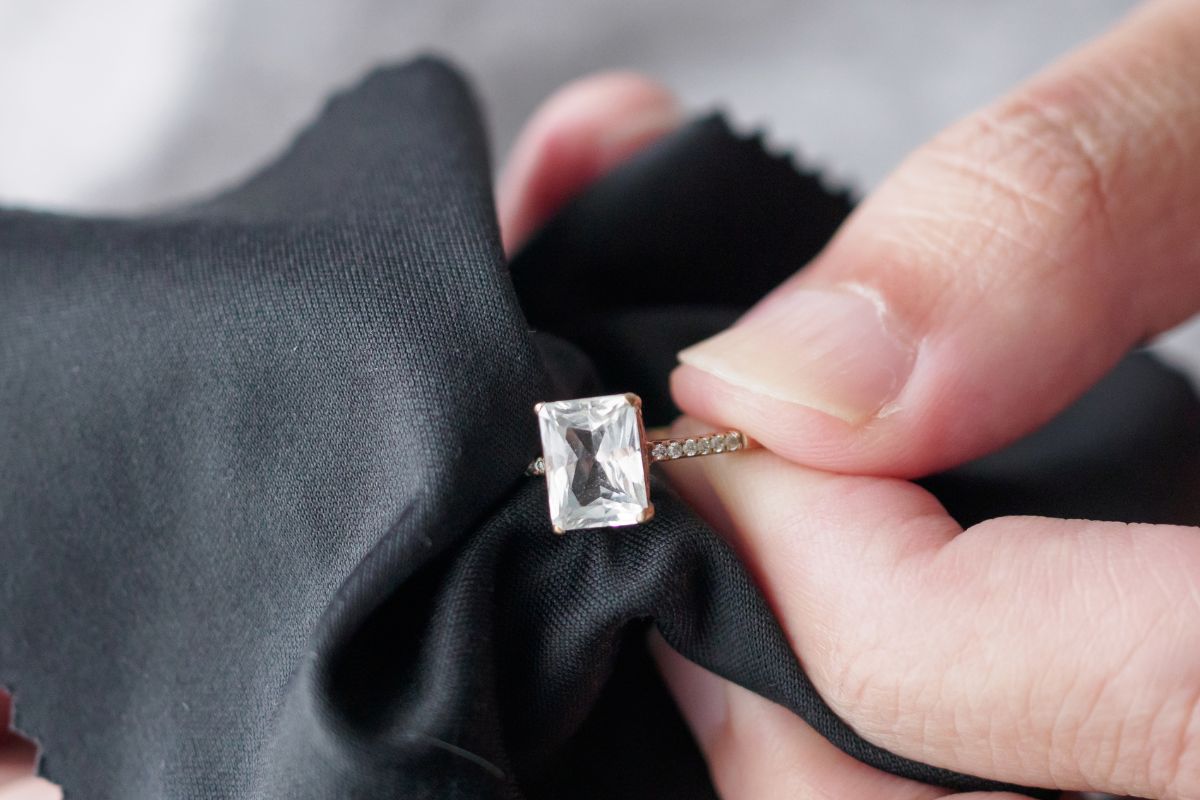
As someone deeply familiar with the intricacies of diamond care, I'm committed to ensuring your precious stones remain as brilliant as the day they were purchased. The longevity and sparkle of your diamond jewelry, whether they're in bracelets, earrings, or engagement rings, depend on consistent maintenance and care.
Regular Cleaning and Checking
For regular cleaning: I recommend a simple solution of warm water and mild dish soap. Soak your jewelry for about 20 to 30 minutes, and then gently brush the diamond with a soft toothbrush. This method will take care of removing everyday dirt and maintaining your diamond's sparkle.
- For checking settings: I advise a bimonthly check to ensure the prongs are intact, especially for engagement rings, which are subjected to frequent wear. A loose prong can lead to a lost diamond, so it's crucial to preemptively address this issue.
Preventing Damage and Loss
To prevent damage:
- Be mindful to remove diamond jewelry before engaging in strenuous activities. Diamonds can chip if struck with enough force.
- Store your jewelry separately to avoid scratches. Soft cloth pouches or lined jewelry boxes are ideal.
- Keep clear of harsh chemicals, as they can erode metal settings over time.
To prevent loss:
- Ensure that clasps and closures on bracelets and necklaces function correctly.
- For earrings, always use secure backs to prevent them from slipping off unnoticed.
Professional Servicing Recommendations
For professional maintenance, I advise:
- Annual inspections: A jeweler can identify and fix issues like loose settings or worn mountings.
- Deep cleaning: Although home cleaning works well for maintenance, a professional cleaning at least once a year is recommended to restore your jewelry's luster.
Sustainable and Ethical Considerations

When considering the purchase of princess cut diamonds for engagement rings or other pieces of jewelry, I prioritize not only the beauty of the stone but also the sustainability and ethics behind its acquisition.
Natural vs. Lab-Created Diamonds
- Natural Diamonds: These are mined from the earth, often involving extensive geological processes. For a more sustainable choice, look for retailers that offer princess cut diamonds from mines adhering to strict environmental and labor standards.
- Lab-Created Diamonds: Alternatively, princess cut lab diamonds are a sustainable option because they require no mining. The production of lab diamonds uses advanced technological processes that mimic natural diamond formation, resulting in physically and chemically identical gems without the environmental toll of mining.
Ethical Sourcing and Conflict-Free Diamonds
Ethical sourcing of princess cut diamonds is essential to me. This ensures that the diamonds are conflict-free, meaning they have not financed civil wars or violent conflicts. To buy a diamond that aligns with these values, seek out vendors who can provide certification of their diamonds' origins, such as the Kimberley Process certification, which guarantees that the rough diamond has been sourced from a conflict-free zone.
Environmental Impact
Mining for natural diamonds can significantly impact the environment. It involves altering landscapes, affecting ecosystems, and using large amounts of water and energy. Thus, when you choose a natural diamond, opt for those mined by companies that are transparent about their sustainability efforts and are committed to minimizing their environmental footprint. Conversely, lab diamonds offer a controlled environment where the energy used can be sustained from renewable sources, which considerably reduces their environmental impact.
Final Thoughts on Princess Cut Diamonds

Princess cut diamonds have solidified their place in the hierarchy of diamond cuts with their unique blend of sharp lines and brilliant sparkle. As I share these thoughts, remember that selecting the precise size from a princess cut diamond size chart is crucial to ensure the right balance between carat weight and how the diamond presents on the band.
The allure of a princess cut lies in its ability to offer a contemporary aesthetic while maximizing the stone's brilliance. While perusing a size chart, it’s paramount to keep in mind that a princess cut's appearance hinges not only on carat weight but also on the diamond's overall proportions.
Key Considerations for Princess Cut Diamonds:
- Carat Weight to Size Correlation: Each increment in carat weight correlates with a proportional increase in millimeter dimensions. However, this increase is not always linear, so it’s essential to consult the size chart for accurate dimensions.
- Cut Quality Impacts Appearance: A well-cut princess diamond will exhibit exceptional sparkle and symmetry, whereas a poorly cut stone may not reflect light as effectively.
When you're in the market for a princess cut diamond, move forward with the following in mind:
- Confidence in Choice: The size chart is a critical tool for understanding what you're purchasing. Use it to feel confident in your choice, as the visual size of the diamond correlates closely with its carat weight.
- The Visual Appeal: The quintessential square shape should be your target, aiming for an ideal length-to-width ratio close to 1:1 to ensure the diamond maintains its characteristically square appearance.
Also Read
Frequently Asked Questions
In this section, I will clarify common queries regarding the relationship between carat weight and size for princess cut diamonds, as well as provide insights into typical measurements and comparisons with other diamond shapes.
How is the carat weight of a princess cut diamond related to its size in millimeters?
The carat weight of a princess cut diamond is proportionally related to its size in millimeters. As the carat weight increases, the length and width in millimeters typically increase as well. However, the specific dimensions can vary due to the diamond's cut proportions.
What are the typical dimensions for a 1 carat princess cut diamond?
A 1 carat princess cut diamond typically measures approximately 5.5mm by 5.5mm. However, this can vary slightly depending on the diamond's cut quality and specific proportions.
How can I compare the size of princess cut diamonds to other shapes?
To compare the size of princess cut diamonds to other shapes, you can look at the stone's face-up area in square millimeters. This gives you a comparison of visible size, irrespective of diamond shape.
What measurements constitute a well-proportioned princess cut diamond?
Well-proportioned princess cut diamonds usually have length-to-width ratios between 1.00 and 1.05 for a square shape. They also have even and symmetrical facets that maximize sparkle and symmetry.
How does the carat weight of a princess cut diamond affect its perceived size?
The carat weight of a princess cut diamond affects its perceived size as it relates to the diamond's top surface area, which is what is visible when set in a ring. A higher carat weight typically means a larger appearance, but cut quality can influence this perception.
What size does a 2 carat princess cut diamond typically measure?
A 2 carat princess cut diamond typically measures around 7mm by 7mm. However, exact measurements can vary slightly based on the cut and proportions of the specific diamond.
Checkout some of our top collections:
Leave a comment
Please note, comments must be approved before they are published.
